|
Welcome to the Spring issue of the LIFE Dee River newsletter!
|
|
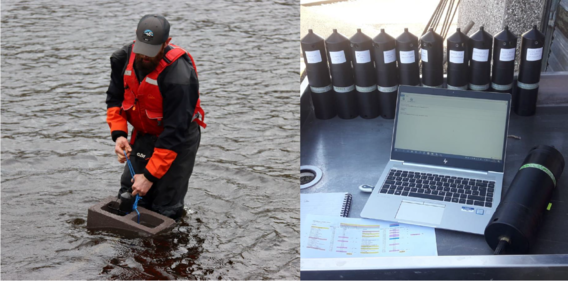 Deployment of Acoustic Receivers
The LIFE team are entering a key phase of monitoring as we try to establish baseline information around lamprey and salmon migration within the Dee catchment. The run of river lamprey (Lampetra fluviatilis) migrating into freshwater probably started in October last year with small numbers (based on sparse historic evidence) but should reach its peak this month. This will hopefully be followed by the arrival of sea lamprey (Petromyzon marinus) into freshwater next month. Our new mobile trapping method has allowed us to sample quite a number of lamprey and will hopefully continue to provide specimens for our monitoring work.
Over the next few weeks, we will be deploying over 40 acoustic receivers throughout the catchment and these will be used to assess the speed and passage of these species into the river and around structures. By surgically implanting acoustic tags in up to 65 specimens (40 river lamprey and 25 sea lamprey), we hope to establish key behaviours, delays and impacts around these potential barriers to migration. We are starting from a very low baseline and the information gathered will be invaluable as we address several of our key intervention sites. We also hope to establish the extent of migration after our interventions and identify key spawning areas over the next four years.
The acoustic research will not be limited to lamprey species. In collaboration with the Welsh Dee Trust (WDT), we intend to tag 40 adult salmon (Salmo salar) at Chester to look at upstream migration and downstream migration of salmon smolts in conjunction with the Bala Sluices smolt tracking study. We would like to offer thanks to the WDT for the purchase of 10 acoustic tags to help further our understanding of the behaviour of adult salmon in the Dee, and subsequently demonstrate the benefits of the interventions carried out under the LIFE Dee River project.
|
|
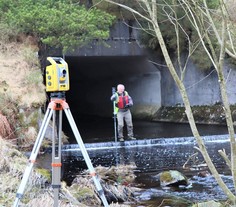
Over the past few months, our River Restoration Officers have been busy preparing projects which will be delivered in Summer 2021. Major habitat improvements are planned for the upper Afon Brenig and Afon Alwen, which will include the introduction of large amounts of gravel and the repositioning of boulders within the channel. This will help provide shelter, temperature regulation and better spawning habitat for all fish species including salmon, sea trout and brown trout.
Currently, for fish to easily access the very upper reaches of the Afon Alwen they need to swim through a large 50 meter culvert below the B4501 road between Cerrigydrudion and Denbigh, which has been identified as a significant barrier to all fish on lower flows. We have appointed consultants to provide a better solution for fish passage at this location and having recently carried out a topographic survey at the site, we hope to receive outline designs very soon to progress with the project.
|
|
|
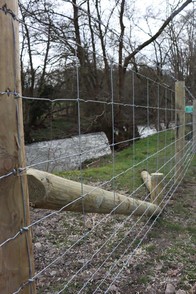
As you may remember from our last newsletter, our target was to erect 2.5km of fencing this winter. We have managed to surpass this target and have already completed over 3.9km of fenced riverside corridors along the main river and the tributaries that flow into the Dee. These riverside corridors are very effective at excluding stock from poaching the banks and stopping sediments and nutrients from entering the Dee. The corridors act as buffer strips that protect the rivers as well as encouraging the riverside ecosystems to flourish.
Additionally, at Llangollen Golf Course, we have planted 140 mixed native trees to stabilise the riverbank which will help reduce the amount of eroded sediment entering the river and will provide additional habitat for wildlife.
Since the launch of the project, several riverside corridors have been created across the catchment including the main river near Llangollen, around the Bangor on Dee area, as well as higher up in the catchment on the Afon Mynach and Afon Tryweryn. The riverside corridors vary in length and we have worked closely with the landowners and tenants to establish which approach would be most beneficial to both the river and the land. If you are interested in working with us to create a fully-funded riverside corridor on your land, please feel free to get in touch with us at lifedeeriver@cyfoethnaturiolcymru.gov.uk
|
|
|
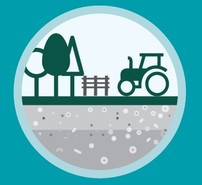
In January, new regulations were announced by the Welsh Government which places the whole of the country under Nitrate Vulnerable Zone (NVZ) regulations from this April. This means there will be tighter restrictions with regards to the storage of slurry, periods where spreading will be prohibited, as well as a requirement to record and follow total nitrogen loading figures.
Our farm visits will be able to support your business to prepare for these new regulations. Below are some of the techniques and measures we can offer:
• Calculate available slurry storage
• Total nitrogen loading calculations
• Potential for on-farm interventions which may result in less rainfall entering slurry storage
• Advice on internal and external grants which may be of benefit to your business
• General advice and reassurance on the new regulations
If you’re interested in finding out more about how we can support you, or would like to arrange a farm visit, please contact our Land Management Officers for a chat:
Ifor: ifor.potts@cyfoethnaturiolcymru.gov.uk | 07971 545474
Tomos: tomos.wynne@cyfoethnaturiolcymru.gov.uk | 07917 214791
|
|
|
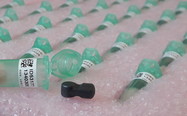
Under the LIFE Dee River project, a new framework for fisheries monitoring equipment has recently been set up. This framework is for various specialist pieces of monitoring equipment that will be used by the project team throughout the lifetime of the project and beyond. The framework includes separate lots for Passive Integrated Transponder (PIT) technology, underwater acoustic cameras, automatic fish counters and acoustic telemetry equipment to allow us to understand the movements and behaviours of fish in the freshwater and marine environment.
This framework builds on many years of use and experience within the specialist areas in this field, and formalises previous purchases, following a competitive tender process that was advertised on the Official Journal of the European Union (OJEU).
RS Aqua are one of the suppliers and will be providing acoustic tags to the project (and other tracking studies across Wales) and have recently published details of their involvement on their website here.
|
|
|
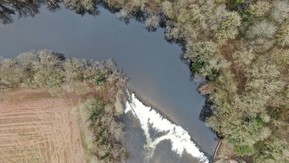
Capturing high quality imagery and footage is an important aspect of the project, not only as a record of the work being carried out but primarily to monitor the impacts of our interventions, as well as researching hard to reach areas, and as a visually engaging tool for our communications. With many of the project officers visiting sites along the catchment regularly, one of the best ways to maximise these opportunities is to use a drone to fly over these sites and capture imagery from a range of different perspectives.
Having recently undertaken a rigorous training course, we now have licenced drone pilots in the team who will be gathering as much data as possible over the next four years, helping to deliver a robust evidence base and providing quality imagery to share updates with you all through our communication channels – keep an eye out on our social media to find out where we’ve been flying recently!
|
|
|
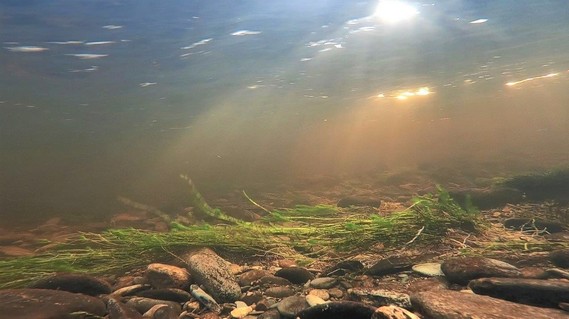
- In procurement news…The LIFE Dee River Restoration Framework tender opportunity will be published at the end of this month! The £1.5m framework includes fencing, tree planting, brash revetment works, minor weir removals and gravel and boulder placement. Keep a look out on Sell2Wales and eTender Wales to apply.
- With a project like this, it is vital to ensure that work is carried out in an environmentally sensitive way, and as a result we are busy applying for various permissions and licences such as Flood Risk Activity Permits and Habitat Regulations Assessments. This is to ensure that work carried out by ourselves or appointed contractors is undertaken in a manner that will not cause damage to the environment.
- Our winter fencing and tree planting programme across the catchment will be completed within the next month. Following Storm Christoph, we’ve assessed all fencing previously completed under the project, and are pleased to say that only 6 meters was damaged during the record floods in January and will be repaired by the contractor in the next few weeks.
- Over the next three months, we will be publishing outline designs for in-river structures and will be engaging with our local communities to discuss these plans and the positive outcomes we aim to bring.
|
|
|
|